Examples of Mobility on Demand Policies and Public-Private Partnerships to Increase Accessibility
20 minutes Author: Shared-Use Mobility Center & National Center for Mobility Management Date Launched/Enacted: Jan 6, 2020 Date Published: January 7, 2020
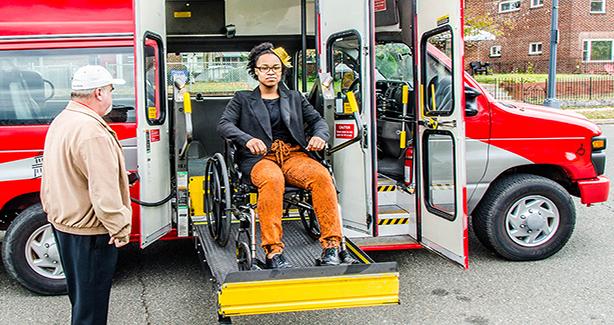
For questions about this report, please contact Judy Shanley. Ph.D., Easterseals Director, NCMM: jshanley@easterseals.com or Albert Benedict, Research Manager, Shared-Use Mobility Center: Albert@sharedusemobilitycenter.org
Brief Summary
- This case study reviews many policies and shared mobility projects that serve people with disabilities.
- New technologies present an opportunity also to expand shared mobility options for people with disabilities.
- Policymakers must include individuals with disabilities in planning and policy decisions.
- Coordination of policy across different levels of government can help ensure that shared mobility better serves people with disabilities.
Introduction
This case study offers examples of policies and pilot programs that take into consideration the transportation needs of persons with disabilities. The examples are organized by Policies and Service Coordination & Trip Planning Programs. The examples were identified and compiled for a poster session at the Transportation Research Board (TRB) 99th Annual Meeting. Each example provides an overview of how the program featured works, unique partnership qualities, and additional information.
The Issue & Potential
Recent technological advances have driven an unprecedented expansion of the menu of transportation services available to users, especially through the integrated set of tools and services together known as Mobility on Demand (MOD).
New mobility services have emerged in the last ten years that leverage advancements in mobile technology and digital platforms to connect riders with mobility services across diverse transportation modes. These advancements in new transportation services and innovative technologies have the potential to ensure access to diverse transportation options for all. A vast number of the new services utilize essential concepts of shared-use mobility, which is characterized by the Federal Transit Administration (FTA) as “transportation services that are shared among customers, including transit agencies; taxis and limos; bike sharing; car sharing (round-trip, one-way, and personal vehicle sharing); ridesharing (car-pooling, van-pooling); ridesourcing; scooter sharing; shuttle services; neighborhood jitneys; and commercial delivery vehicles providing flexible goods movement.”
Accessibility of shared-use mobility systems is an essential consideration to provide enhanced mobility for people with disabilities. Shared-use modes are appealing for this group for several reasons. First, shared-use mobility services promote independence by reducing the need to rely on friends, family, or caregivers to provide transportation in fulfillment of everyday activities. Second, these services are on-demand and flexible, reducing the need to book trips far in advance, and can be routed to efficiently serve customers. Third, the costs of shared-use mobility services may be cheaper to people with disabilities than other transportation options. Fourth, shared-use mobility can fill gaps in fixed-route transit and paratransit service. Together, these aspects of shared-use mobility offer significant quality of life benefits for people with disabilities to access everyday destinations, such as employment, medical appointments, education, and recreational activities.
Growth of Shared Mobility
Examples of shared-use mobility can be found throughout the United States from urban centers to small towns and even rural areas. The map below helps to illustrate the widespread availability of shared mobility across the United States. The symbols on the map are coded by shape and color to represent different modes of shared mobility, including carshare, bikeshare, electric scooters, ridesourcing, ridepooling and microtransit. At the time of this writing, of the top 50 metropolitan areas in terms of population, all of them have a form of ridesourcing, 47 have a form of carshare, 41 have a form of bikeshare, and 31 have electric-scooters.

North American Shared Mobility Landscape, 2019. SUMC.
The rise of shared-use mobility services across the country corresponds with growth of partnerships between shared-use mobility providers and public transportation agencies. However, some of these partnerships raise concerns regarding equitable access to services for people with disabilities. Additionally, descriptions of these partnerships do not consistently include reference to how the service impacts riders with disabilities. With an increasing number of public & private providers entering this space, policies and programs are needed to ensure that people with disabilities also have access to equitable shared-use mobility service with a high standard of quality. In response to this growing need, the former U.S. Department of Transportation Secretary Anthony Foxx published a “Dear colleague” FTA guidance in December 2016, advising transit agencies that they are obliged to “ensure equity and access as you partner with TNCs.” The guidance clarified that ADA regulations apply regardless of federal funding and apply to public and private transportation providers. What’s more, demand-responsive service needs to be deemed “equivalent” to services provided to other individuals in the areas of:
- Response time;
- Fares;
- Geographic area of service;
- Hours and days of service;
- Availability of information and reservations capability;
- Any constraints on capacity or service availability; and
- Restrictions or priorities based on trip purpose.
To take advantage of these new transportation options, public transit agencies are increasingly turning to public-private partnerships (P3s) with shared mobility operators to help provide mobility options for everyone. This factsheet offers examples of state and local shared mobility policies and P3 pilot programs that consider the needs of seniors and persons with disabilities. It is important to note, while some of these examples may not meet the needs of every person with a disability, the cases discussed offer a base of knowledge to continue building equitable and accessible on-demand transportation solutions. Equally important, involving users with varied transportation needs in the planning and development of either a policy or program is important to assuring its success.
Policies
The policies reviewed in this factsheet primarily address Transportation Network Companies (TNCs). TNCs began operating across cities in the U.S. and were quickly adopted as a transportation mode and their use skyrocketed. Given this rapid growth, cities and states were often caught off-guard as the regulatory policies were not designed with this new shared technology in mind. Recent policies and public-private partnerships have helped to close this gap, and we are now seeing evidence that TNCs could be one of many transportation modes available to help meet the needs of individuals with disabilities. Following are state and local examples that have both regulated and enabled TNCs to provide accessible transportation solutions.
Arizona – Expansion of TNCs as Non-Emergency Transportation (NEMT) Option for Medicaid Recipients

Uber and Lyft stickers on driver’s windshield
How it works: The Arizona Health Care Cost Containment System (AHCCCS) announced a policy change effective May 1, 2019 that allows TNCs to register as NEMT medical transportation providers. Medicaid recipients in Arizona can use their benefits to pay for Lyft rides to and from medical appointments. AHCCCS stated that adding TNCs as NEMT providers “can add flexibility to the health care delivery system and increase transportation options for Medicaid members.” The policy establishes TNCs as a new AHCCCS provider category. However, these rides are only servicing people on Medicaid who do not require personal assistance during medically necessary transportation. This still leaves traditional NEMT providers to serve Medicaid members who have specialized needs and are not ambulatory. Lyft was the first rideshare company to receive approval to register as a non-emergency medical transportation (NEMT) provider in June 2019.
Unique partnership qualities: One of the first of its kind, this state policy enables rideshare companies like Uber and Lyft the opportunity to provide on-demand service to Medicaid members that do not require personal assistance. This state level policy provides additional service to 1.7 million people and could potentially save millions of dollars.
Additional information:
- Arizona Health Care Cost Containment System (AHCCCS) Transportation Network Companies Now Eligible to Provide Medicaid Services
- MedCityNews: Lyft opens up access to covered rides for Arizona’s 1.7 million Medicaid patients
California – TNC Access for All Act

How it works: This bill requires TNCs to provide access for people with disabilities, including wheelchair users who need a WAV. The California Public Utilities Commission (CPUC) is charged with developing TNC regulations that address issues relating to accessibility for persons with disabilities who use TNCs, with input from relevant stakeholders including “California cities and counties, disability rights organizations, persons with disabilities, transportation and transit agencies, social service transportation providers, paratransit coordinating councils, and TNCs.” This act also requires the CPUC to assess a fee on TNC rides to fund accessible transportation services for persons with disabilities, establishes criteria for exempting TNCs that meet accessibility standards from the fee, and creates criteria for using the fee revenues to provide on-demand accessible transportation services. Upon passage of the bill on September 22, 2018, CPUC began to conduct workshops with relevant stakeholders to determine the adequate WAV demand and supply, fee pricing, and geographic areas for fee collection and distribution. According to ruling 19-02-012, TNCs are required to collect a ten cent ($0.10) fee on each TNC trip in California starting July 1st, 2019. Monies are collected based on the number of TNC trips within each county and are deposited in an “Access Fund.” These funds would be distributed on a competitive basis to access providers that establish on-demand transportation programs to meet the transportation needs of people with disabilities in each county. The act requires CPUC to report to the Legislature by January 1, 2024 on compliance with the act and on the effectiveness of on-demand mobility programs sponsored by the Access Fund. The act repeals these provisions on January 1, 2026.
Unique partnership qualities: CPUC has engaged a diverse group of stakeholders, including persons with disabilities, to guide TNC regulations across the state. CPUC also established an Access Fund to meet the mobility needs of persons with disabilities.
Additional Information:
- California Public Utilities Commission (CPUC) TNC Accessibility for Persons with Disabilities Program (SB 1376, Hill)
- California Senate Bill 1376 (Hill 2018), Public Utilities Code § 5440.5
- California Public Utilities Commission (June 27, 2019) CPUC Rulemaking 19-02-012 – Decision On Track 1 Issues: Transportation Network Company Trip Fee and Geographic Areas
Illinois – Chicago WAV Requirement and Accessibility Fund

City of Chicago Business Affairs and Consumer Protection. Screen capture of Taxicab Excellence Awardee 2016 video.
How it works: The City’s Vehicle Accessibility Fund, which is supported by fees paid by the taxi and TNC industries at ten cents ($0.10) per every trip performed by a non-accessible vehicle. Transportation network provider (TNP) Accessibility Requirements state that the TNP digital platform connecting drivers and passengers must be accessible to customers who are blind, visually impaired, deaf and hard of hearing; plus, the TNP must implement plans to enhance service to customers with disabilities. The Fund has allowed the Department of Business Affairs and Consumer Protection (BACP) to offer incentives to increase the number of WAV vehicles in Chicago’s streets. In 2012, the city began offering a $15,000-$20,000 incentive to convert a vehicle to a WAV taxicab or purchase a factory-built WAV taxicab. In 2016, the city of Chicago created new incentives, including an exemption of fees charged to WAV medallion holders for dispatch service, a $10,000 “early bird” incentive to medallion owners that purchased WAV taxicabs in 2016, and up to $5,000 in an annual grant for WAV taxicab owners for vehicle maintenance.
Unique partnership qualities: The Vehicle Accessibility Fund has been used to increase the numbers of WAVs through purchase and maintenance subsidies. Since the policy was enacted, the number of WAV taxicabs operating in Chicago has increased from 91 to 436, more than quadrupling the city’s fleet.
Additional Information:
- Chicago Business Affairs and Consumer Protection. TNP License Fact Sheet.
- Chicago Mayor’s Office for People with Disabilities. Financial Incentives to Increase Number of Wheelchair-Accessible Taxicabs.
- Chicago Data Portal. Public Passenger Vehicle Licenses: City of Chicago: Data Portal
- Chicago Business Affairs and Consumer Protection: Transportation Network Providers
- Chicago Wheelchair Accessible Taxis
Massachusetts – MBTA The RIDE and MassDOT Pilot Program to Increase WAVs
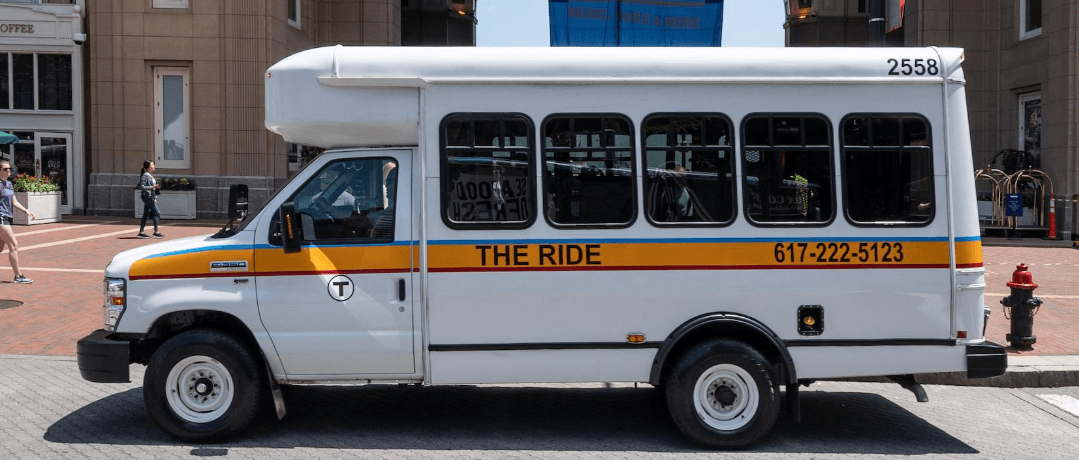
Credit: MBTA The Ride
How it works: The MBTA in Boston, Massachusetts launched the well-documented on-demand paratransit pilot program in September 2016. The overarching goals for the pilot were to reduce the cost of providing ADA paratransit by shifting trips to lower cost TNC services, while increasing the mobility of its customers. Both Uber and Lyft have worked with the MBTA and/or third-party vendors to provide trip request, service, and payment options that are ADA compliant. The most recent development is the joint effort between MassDOT and MBTA that directly subsidizes TNC operators to increase the number of WAVs in service. The pilot will reimburse participating TNCs with a fixed, $24 per-hour subsidy for each hour that a WAV is available on TNC platforms. The goal of this pilot is to quadruple the WAV supply hours. The per-trip fee assessed through Massachusetts’ 2016 Act, “Regulating Transportation Network Companies” will be used to reimburse participating TNCs in exchange for providing on-demand WAVs within The RIDE service area. This is an example of state policy being used to improve access to shared-use mobility for people with disabilities. New information will be provided on a monthly basis to allow the MBTA to monitor the program and make programmatic changes as necessary.
Unique partnership qualities: MBTA The RIDE is an example of both a pilot and how policies can be leveraged to increase accessibility from within the pilot through $2.4 million subsidy to increase WAVs. The RIDE was one of the first public transit and TNC public-private partnerships created to address the mobility needs of persons with disabilities.
Additional Information:
- MassDOT and the MBTA to Partner with Transportation Network Companies to Support More Wheelchair-Accessible Vehicles
- King County, Washington. Wheelchair Accessible Services Fund – Disbursement
Washington – King County Wheelchair Accessible Services Fund
How it works: This county-level policy enacted in 2016 stipulates that a TNC will pay a ten cent ($0.10) wheelchair accessibility fee surcharge for all rides originating in Unincorporated King County, or any municipality that contracts with the county for the county to license taxicabs, for-hire vehicles, or TNCs that operate in the municipality. The fee surcharge shall be used to offset the operational costs incurred by the owners and operators of wheelchair accessible taxis, wheelchair accessible for-hire vehicle or wheelchair accessible transportation network company endorsed vehicle services including, but not limited to, the costs associated with purchasing and retrofitting an accessible vehicle, fuel and maintenance costs and the time involved in providing wheelchair accessible trips. Funds are disbursed in three categories: Dispatched Wheelchair Passenger Trip Reimbursement, Wheelchair Accessible Service Vehicle Maintenance/Acquisition, and the Wheelchair Accessible Service Training Fund. The policy is in line with fund collection and disbursement administered by the City of Seattle Regulatory Compliance and Consumer Protection Division, which ensures streamlined and simplified compliance for taxicab or TNC drivers across Seattle and King County.
Unique partnership qualities: Seattle established a Wheelchair Accessible Services fund in 2015, followed by King County the following year. King County’s fund is featured above, but both collect $0.10 per TNC trip and are designed to offset the costs of providing wheelchair accessible vehicles. Open for comment through December 30, 2019, Seattle and King County have established a joint WAS fund that will supersede their respective ordinances.
Additional Information:
Service Coordination & Trip Planning Programs
The policies discussed above are only effective when programs are designed around them to more fully meet the mobility needs of all of its users. Following are examples of mobility on-demand public-private partnerships that have planned for and provide mobility options to increase accessibility.
California – Oakland Adaptive Scooter Pilot
How it works: In January 2020, Oakland, CA launched an adaptive e-scooter pilot program in partnership with Lime. The pilot includes 75 Lime scooters that have been adapted for the needs of people with disabilities, including adjustable seats, larger wheels for smoother travel over bumps, and wider handlebars for better balance. Unlike the traditional e-scooters that are available throughout the city and can be picked up at random, these adaptive scooters must be ordered through the Lime app and one will be delivered to the requested location. They cost $32 for 24-hours of use.
Unique partnership qualities: In July 2019, San Francisco required that shared mobility operators provide access to people with disabilities as part of its permitting process. Lime’s application for a permit included details on its plan to launch this adaptive scooter pilot within three months of receiving a permit, and scale up to 75 scooters within 6 months.
Additional information:
- Streetsblog: “Oakland’s New ‘Adaptive’ Scooters”
- Lime San Francisco Permit Application
- Fast Company: “E-scooters are leaving people with disabilities behind. Lime wants to fix that”
California – Mobility On-Demand Every Day, Big Blue Bus (BBB), Santa Monica
How it Works: In July 2018, BBB, Santa Monica’s bus operator, alongside the non-profit social services organization WISE and Healthy Aging, replaced its previous dial-a-ride (DAR) program by rebranding to Mobility on Demand Everyday (MODE). Trips within the city of Santa Monica are made by shared, on-demand DAR service via Lyft. The purpose of MODE is to improve the customer experience, provide same-day mobility options for DAR customers, and reduce the cost of DAR service for BBB. All trips cost $0.50, and customers may travel with up to three companions at an additional cost of $.50 each, or one personal car attendant for $0.25. Customers must be age 60 or older, or age 18 or older with a disability; registered through MODE; and certified by WISE and Healthy Aging. Wheelchair and door-through-door customers can reserve a BBB-operated vehicle by phone for same day pickup.
Unique partnership qualities: BBB was able to address ADA concerns by providing service through the transit agency itself by allowing customers to request a wheelchair-accessible vehicle (WAV). The program is being funded by the budget of BBB and is a permanent service offering.
Additional Information:
- Big Blue Bus. Mobility On-Demand Every Day Program.
- American Public Transportation Association. Transit and TNC Partnerships.
California – Lyft partners with First Transit for on-demand paratransit pilot in San Francisco & Los Angeles
How it works: In August 2019, Lyft announced a 12-month pilot program in partnership with First Transit in San Francisco and Los Angeles, CA. After enabling Access Mode in the Lyft app, customers can request a WAV that accommodates their fixed-frame or non-collapsible wheelchairs. First Transit – a national mobility provider – will then provide a WAV from its fleet of dedicated 2019 Toyota Siennas. First Transit is also responsible for operational support and maintenance of the vehicles, as well as for providing 60 hours of training to its drivers. Each of the WAVs are equipped with ramps and safety tie-downs.
Unique partnership qualities: Throughout the pilot, Lyft will analyze trip data to assess program success and viability. Because First Transit’s fleet of WAVs is allocated to this pilot program, its drivers will not pick up other types of fares.
Additional information:
California – Ford GoBike Adaptive Bikeshare Pilot, Oakland
How it works: Ford GoBike, the incumbent bikeshare program operated by Motivate in the Bay Area, partnered with the City of Oakland, California, the Metropolitan Transportation Commission, and the Bay Area Outreach and Recreation Program (BORP) to launch an adaptive bikeshare program for users with disabilities for the summer 2019. The program included five types of adaptive bikes, as well as adaptive equipment such as supportive pedals, seats and straps, and hand pedals for quad level SCI riders. There was no charge for people with disabilities, and users without a credit card can register online through the Bike Share for All Program.
Unique partnership qualities: BORP volunteers fit users to the various bike models, and they provided rider training. BORP plans to build an online reservation system, but for the summer 2019 program, the bikes were available on a first-come, first-serve basis, or could be reserved in advance via phone or email. BORP’s webpage includes additional features and a FAQ section.
Additional information:
- Ford GoBike Adaptive Bikeshare Pilot, Oakland, CA, 2019
- “Oakland, CA bike-share pilot caters to people with disabilities” Smart City
- Ford GoBike release
Connecticut – Norwalk Wheels2U Microtransit
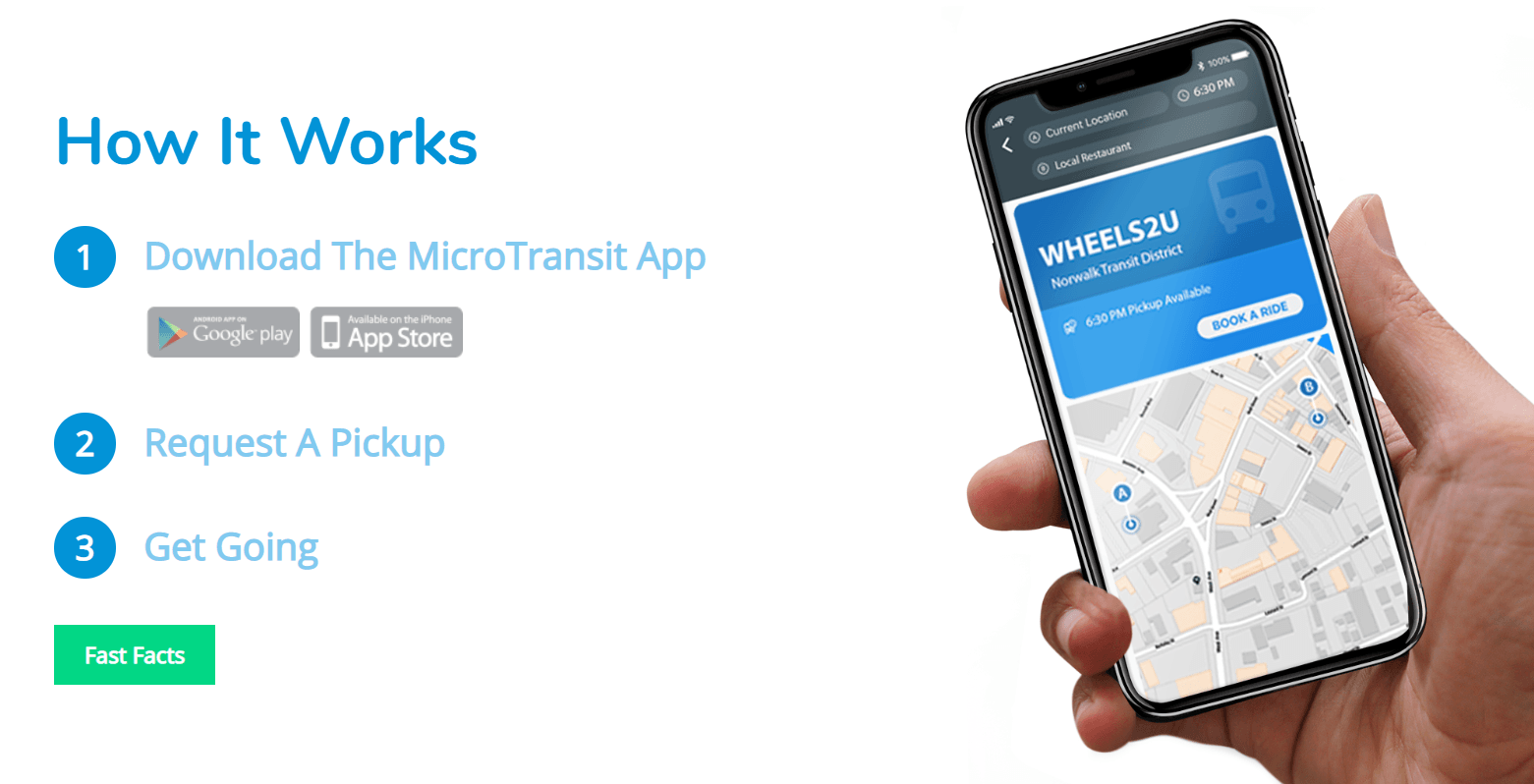
Credit: Norwalk Transit District
How it works: Wheels2U started as a six-month pilot project in September 2018 using off-peak Norwalk Transit District (NTD) paratransit vehicles to increase mobility options within its downtown and adjacent neighborhoods. The agency decided to use demand-responsive microtransit service that can sometimes be operated more efficiently and at a lower cost than fixed-route service. Normally the vehicles are part of the transit district’s paratransit fleet, but the program uses vehicle otherwise sit idle during the evening. By using its own fleet of WAVs the transit agency has been able to remove some of the most common barriers to entering into a public-private partnership, those being insurance, accessibility and driver training. Further accessibility measures will be implemented when the service becomes permanent, offering additional ways to schedule a ride, including SMS text notifications and a dispatch/call center. The project included funding from the FTA and the Connecticut Department of Transportation (CDOT). The Norwalk Transit District also partnered for local funding support and promotional services with local mall developer Brookfield Properties, the Norwalk Redevelopment Agency, and other local businesses and restaurants. In early 2019, the transit district issued an RFP to make the service permanent and in June, 2019 they announced their partnership with Via to continue the service on a permanent basis starting September 2019.
Unique partnership qualities: The service is able to take advantage of off duty ADA paratransit vehicles to provide the on-demand transportation in Downtown Norwalk and its adjacent neighborhoods. In this public-private partnership, the private partner provides the on-demand and routing technology and the transit agency is responsible for the vehicles and drivers. This P3 type of arrangement has helped to address some of the most common barriers often associated with a public private partnership, such as insurance, driver training and accessibility.
Additional Information:
- Shared-Use Mobility Center and Todd Hansen, Texas Transportation Institute. Case Study: Wheels2U Microtransit Service: Providing Mobility in Options in a Growing Downtown.
Florida – Jacksonville Transportation Authority Pilot for Medical Appointments
How it works: As a recipient of the FTA’s Rides to Wellness Demonstration and Innovation Coordinated Access and Mobility Grants in March 2018, the Jacksonville Transportation Authority (JTA) was working to develop a software interface that will seek to improve connections between medical scheduling services and public transit schedules. For this work, JTA was collaborating with the University of Florida Health, Cambridge Systematics, Smart Transit, and the Health Planning Council to develop and deploy the pilot. Once launched, the software will generate transit travel times and costs for healthcare receptionists and patients to inform them of options when choosing appointments.
Unique partnership qualities: The aim of this program was to collect data regarding improved health outcomes and decreased healthcare costs that arise from linking medical appointments with transit and mobility options. The 18-month pilot is scheduled to release a final report in winter 2020.
Additional information:
- JTA Rides to Wellness homepage
- FTA 2018 Annual Report on FAST Act Section 3006(b) Pilot Program for Innovative Coordinated Access and Mobility
Illinois – Chicago Suburb High School Approves Ridesharing Company to Provide Alternative Transportation for Special Education Students

Credit: Zum
How it works: In June 2019, the School Board overseeing the Evanston Skokie Consolidated School District approved the use of Zum Services, Inc., a ridesharing company that exclusively transports students. With this new provider, Zum drivers will replace taxis providing transportation for the high school’s special education students. Parents can access an app that allows them to see their child’s location in real time. Although the school plans to start phasing in use of Zum slowly, it anticipates saving approximately 15% over the cost of the taxis. Oak Park, a suburb on Chicago’s near west side, is exploring a similar arrangement with Zum and according to the school’s estimates, it anticipates saving approximately $10,000 per month by switching to Zum, a sum of over $70,000 through the remainder of the 2019-2020 school year.
Unique partnership qualities: All drivers are vetted by Zūm, are required to hold a Class D School Bus Permit issued by the Illinois Secretary of State and receive extensive school bus driver training. They also receive specified training in transporting students with special needs and de-escalation techniques. All driver vehicles are inspected twice per year by the Illinois Department of Transportation. The company asserts that it has over 150 partnerships with schools across seven different states.
Additional information:
- Evanston Round Table: “D65 Will Phase in Zum for Transportation”
- “OPRF may hire Uber-like firm to transport special ed students”
Kansas/Missouri – RideKC Freedom On-Demand Program
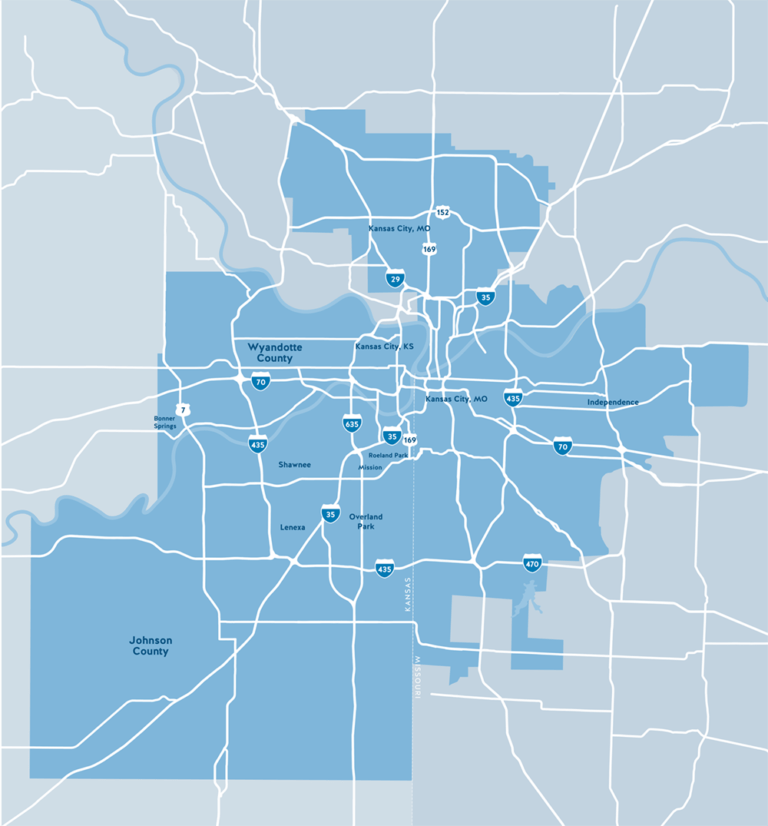
RideKC Freedom On-Demand Service Area
How it works: Launched on March 1st, 2017, this pilot expands travel options for riders with disabilities in the bi-state area. Through the RideKC Freedom smartphone app, or by calling the regional call center, eligible users can book a traditional or ADA-accessible taxi. Freedom On-Demand allows users to book a cab ride without advance reservation. The service complements traditional ADA paratransit service, RideKC Freedom. This project leveraged their existing taxi contract for both ambulatory and WAV service to provide on-demand transportation. About 100,000 trips have been completed on RideKC Freedom On-Demand since the project launched in May 2017. It now provides approximately 8,000 trips each month. A surcharge for non-disabled riders is used to help fund the system. The on-demand pilot falls under the KCATA innovative programs budget, which is self-funded and supported in part by revenue collected through the RideKC freedom app.
Unique partnership qualities: RideKC Freedom has leveraged its existing taxi partnership to provide a universal on-demand transportation solution to increase the mobility for all users. When the program is utilized by persons without a disability a small fee is collected that goes back into the program. The program has expanded its service area since its launch and now provides approximately 8,000 trips per month.
Additional Information:
- Shared-Use Mobility Center. Case Study: RideKC Freedom On-Demand Pilot: Leveraging Existing Contracts for On-demand Paratransit.
- AARP Public Policy Institute Long-Term Services and Supports Scorecard Emerging Innovations: Mobility Managers.
Maryland – Washington Metro Area Transit Abilities-Ride paratransit program
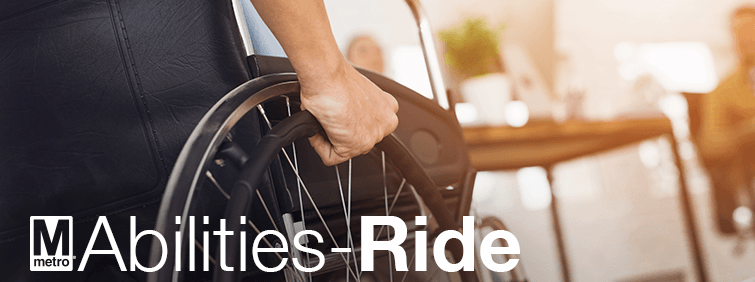
Credit: WMATA
How it works: In partnership with Silver Cab and Regency Taxi, the Washington Metropolitan Area Transit Authority (Metro) launched Abilities-Ride, a program offering subsidized, wheelchair-accessible taxi rides to paratransit-eligible customers. Service area for the program mirrors the service area for the traditional paratransit service, MetroAccess. Customers pay the first $5 of each ride, Metro covers the next $15, and any remaining fare exceeding $20 is covered by the customer.
Unique partnership qualities: User can book up to four rides per day, and one personal care assistant is permitted to travel with the customer at no additional cost. The two participating taxi companies accept requests for same-day rides via phone or through their respective apps.
Additional information:
Michigan – Flint Mass Transit Authority’s on-demand NEMT “Rides to Wellness” Program
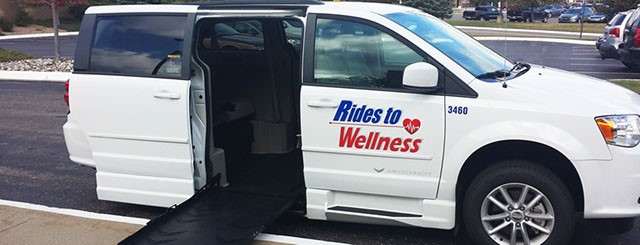
Credit: MTA Flint
How it works: In September 2016, the Flint, Michigan Mass Transit Authority launched its “Rides to Wellness” program, which provides non-emergency medical transportation (NEMT) to residents in the Flint and larger Genesee County area. The program provides eligible recipients with on-demand transportation to their medical appointments, and it also often permits additional stops at pharmacies or grocery stores to fill prescriptions. The service operates from 8am to 5pm weekdays, and drivers are sourced from a number of partnering organizations, including: the Genesee County Department of Veterans Services, the Genesee Health Plan, the American Cancer Society, and the Michigan Department of Health and Human Services. Trips to any of the designated 6 local medical offices cost $85 round trip per person, and rides can be requested on-demand by calling the centralized call center. Rides are free if you are a customer connected with one of the partnering organizations.
The program built on a 2015 FTA-funded Healthcare Access Mobility Design Challenge Grant, and then received an additional $300,000 in federal funds through the FTA’s Rides to Wellness Demonstration and Innovative Coordinated Access and Mobility grants issued in December 2017.
Unique partnership qualities: The program began with access to just 5 vehicles in 2016, and had over 50 by the end of 2018. Similarly, participation in the program rose 69% from August 2017 to August 2018. Customers are told that they can anticipate same-day requests for trips to be fulfilled within 30-minutes.
Additional information:
- Flint Mass Transit Authority’s on-demand NEMT “Rides to Wellness” Program, Flint, MI, 2016
- Flint Rides to Wellness homepage
- Flint Township View news article on R2W program
- Michigan Department of Health & Human Services R2W flyer
- FTA Rides to Wellness Grants
Michigan – Michigan Mobility Challenge for Transit Providers to Improve Customer Service for the Visually- and Hearing-Impaired
How it works: In fall 2018, Feonix – Mobility Rising, a non-profit focusing on improving mobility options for under-served and vulnerable populations, was awarded $457,000 through the Michigan Mobility Challenge grant program. Feonix – in partnership with the Ann Arbor Area Transportation Authority – was tasked with developing technology solutions to improve customer service for the visually- and hearing-impaired, particularly in locating bus stops and final destinations. The effort also designed trainings for bus drivers and dispatchers; these “Disability Awareness Training for Transportation Agencies” programs were first implemented in August 2019.
Unique partnership qualities: The app, when developed and launched, will enable passengers on fixed route transit systems to navigate the bus routes and identify the exact location (within 10 feet) of the pick-up and drop-off points for the bus stops.
Additional information:
Michigan – DOT Developing Statewide NEMT Brokerage System
How it works: In September 2017, the Michigan DOT – in collaboration with non-profit Michigan Transportation Connection, Michigan Public Transit Association (MPTA), MassTrans, the Community Transportation Association of America & area health centers – was awarded over $1 million from the FTA as part of the federal Rides to Wellness Demonstration and Innovation Coordinated Access and Mobility grants. The grant was intended to fund an 18-month project beginning in 2018 to expand a NEMT brokerage system available in part of the state to be available statewide. The project, titled the Michigan Access to Wellness (MATW) Project, aimed to develop software and incorporate non-profit and private transportation providers’ offerings to route calls and requests for transportation-related services. When the FTA grant funding concluded in December 2019, program supervision and support was shifted to MPTA, where the pilot continues. The plan was initially to open 10 regional Mobility Centers to coordinate trips based on location and visit type in that region of the state, although that was later shifted to 5 centers. As of February 2020, Mobility Centers are operating in Lansing and Bay City, and a center in Escanaba is anticipated soon.
Unique partnership qualities: The concept for this service stemmed from the model in Flint, MI, with the hope of making a self-sustaining model state-wide. Individual health centers will incorporate the software and direct clients on how to use the service. Performance will be measured by region, with some metrics including: number of late/missed trips or cancellations/no-shows; average hold times on calls; and trips per appointment type, such as procedural/clinic visits, trip requests and mental health services.
Additional information:
- Michigan DOT developing statewide NEMT brokerage system, Michigan, 2017
- National Aging and Transportation Center article
- FTA 2018 Report: Program for Innovative Coordinated Access and Mobility
- FTA Rides to Wellness Grants
Minnesota – GoDakota County Lyft Partnership

GoDakota Rideshare 101 Presentation Cover Slide
How it works: Dakota County is located southeast of the Twin Cities, and while it is the third largest county in Minnesota, it maintains a land use mix of ⅓ urban, ⅓ suburban and ⅓ rural. In March 2019, Dakota County partnered with Lyft to offer flexible, on-demand rides to individuals with disabilities who receive home and community-based services in the county. These rides supplement existing transportation options and are aimed at making it easier for individuals with disabilities to access jobs and travel independently. The partnership is supported in part by a grant from the Minnesota Department of Human Services. Riders of the service do not pay for their trips out of pocket as the service is covered through Medicaid. As a result, the County tells Lyft the amount that should be uploaded to each user’s account and those funds are then applied to the trip. Response to the new program has been positive, with 75% of the users indicating that they are extremely satisfied with the service, as opposed to 60% of the users indicating that they were dissatisfied with the transportation options before the Lyft pilot. In addition to being more satisfied with the transportation options; 63% indicated that they were able to work more hours or days in a week, 69% indicated that they no longer had to rely on a friend or family member to drive them, 88% felt that their transportation was more reliable and 3% of the respondents were able to find a new job.
Unique partnership qualities: The program is unique in that it uses Medicaid to support Lyft trips for persons with disabilities to access jobs and travel independently. Access to these types of services for persons with disabilities are often difficult to obtain because they fall outside of the more readily available Non-Emergency Medical Trip—but are no less important toward creating personal independence. GoDakota has been well received by its users a with over 75% indicating that they were extremely satisfied with the service.
Additional Information:
- Shared-Use Mobility Center. See the full entry to access the contract and supporting materials. Dakota County partners with Lyft for paratransit rides, Dakota County, MN, 2019.
- GoDakota, Getting Around the County
Minnesota – Southwest Transit launches NEMT pilot program in Minneapolis
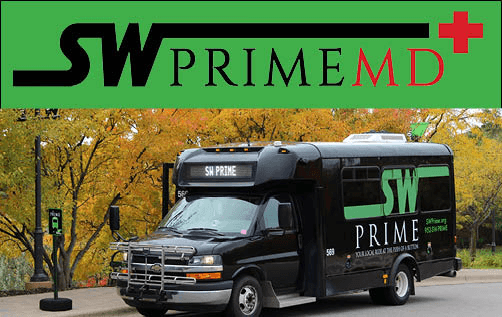
Credit: Southwest Transit
How it works: In September 2019, Southwest Transit launched a pilot program offering NEMT service in the Minneapolis, MN area. To purchase and operate vehicles, the program received funding from a $290,000 grant from the FTA’s FY 2019 Access & Mobility Partnership Grant Program. The service operates from 6:30am to 7:00pm on weekdays, and it provides transportation to any medical facility in Eden Prairie, Chanhassen, Chaska, Carver, and Victoria, as well as other facilities in nearby Minnetonka and Edina. Rides cost $10 each way, and children under 6 ride for free.
Unique partnership qualities: The community of Ridgeview is providing a $5 per trip subsidy for anyone traveling to facilities located in Ridgeview. Rides to appointments can be booked in advance (up to 14 days), but return trips are requested on-demand when the appointment concludes.
Additional information:
Minnesota – Hitch Health and Lyft Pilot Program
How it works: In July 2018, Hitch Health – a healthcare technology company – released the results of a 12-month pilot in partnership with Lyft to provide non-emergency medical transportation to appointments at Hennepin Healthcare internal medicine clinic in Minneapolis, Minnesota. During the pilot, Hennepin provided the contact information for patients in need of transportation who had missed appointments previously. Hitch then offered these customers participation in the service, in which they could request rides via call or text. Hitch would proactively and automatically send patients offers for rides when appointments were scheduled, and it would handle the logistics with Lyft on its end. When the patient was ready to go home, they would text “ready” through the Hitch platform and a Lyft ride would be dispatched. The results released suggest that the pilot resulted in a 27% reduction in the no-show rate for appointments, an increase of $270,000 in revenue for the clinic, and an estimated 297% return on investment.
Unique partnership qualities: Following the conclusion of this pilot and the publication of its results, Hitch announced that it would be expanding this service with Lyft nationally. Hitch claims that its service is unique because its software connects to healthcare providers’ electronic health records to identify patients who may benefit from NEMT. The software allows health systems to customize ride offers through filters. In September 2019, University Hospital in New Jersey launched a similar partnership with Hitch Health in association with Lyft. The Hospital pays Hitch Health a contracted rate, making the Lyft rides free to predetermined customers.
Additional information:
- Hitch Health and Lyft Pilot Program, Minneapolis, MN, 2018
- Hitch Health Home
- University Hospital in NJ launches partnership with Hitch Health, Newark, 2019
Missouri – St. Louis Gateway to Better Health Program with NEMT and Mobile Clinic
How it works: The Gateway to Better Health pilot program is a temporary program for residents of St. Louis City and County, and it serves to provide uninsured adults healthcare coverage as a “bridge” until they can enroll through the Affordable Care Act. In addition to covering costs for primary, specialty and urgent care services for individuals earning an income up to 100% of the Federal Poverty Level, the Gateway program also includes free non-emergency medical transportation to and from such covered medical appointments. A grant from the FTA Rides to Wellness Demonstration and Innovative Coordinated Access and Mobility grant program in the amount of $940,000 enabled the Gateway to Better Health pilot program – which launched service operating in the St. Louis area in July 2012 – to continue service through 2022.
Unique partnership qualities: The federal funding is also facilitating a mobile clinic to provide health screenings such as blood pressure and cholesterol tests at various public transit stations in north St. Louis County. This mobile clinic will serve the healthcare needs of public transit riders along their route.
Additional information:
- Smart Columbus NEMT program for prenatal care, Columbus, OH, 2019
- Gateways to Better Health Homepage
- Gateways to Better Health flyer
- FTA Rides to Wellness Grants
Nevada – RTC Paratransit Partnership with Lyft
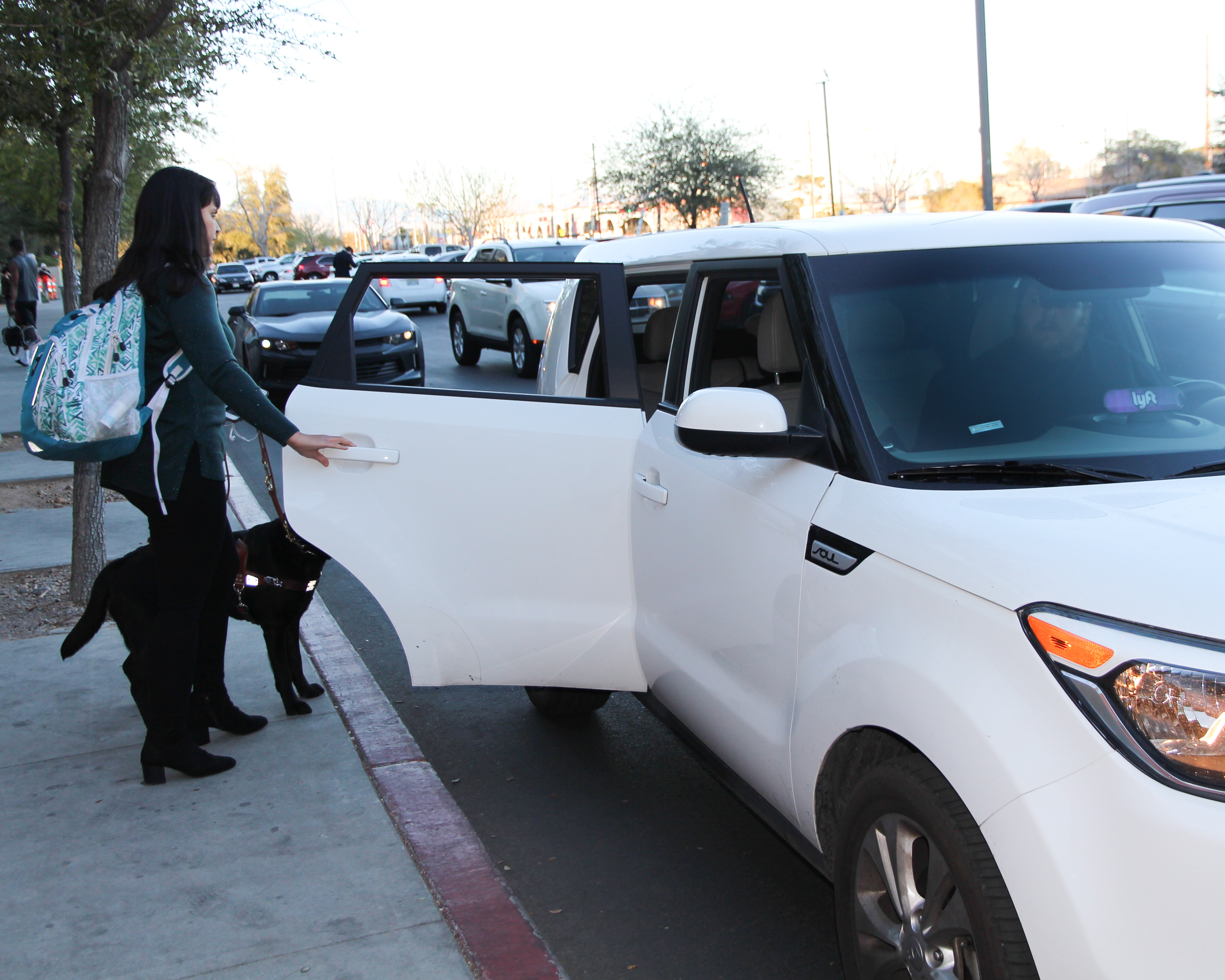
RTC Southern Nevada
How it works: In February 2018, the Regional Transportation Commission of Southern Nevada (RTC) partnered with Lyft to provide on-demand, subsidized rides for paratransit users. Riders can use the Lyft app or the RTC’s Customer Care Center to schedule either a traditional Lyft ride or a shared ride on the pooled Lyft Line service, paying the standard fee of $3, with the RTC subsidizing the rest of the cost, up to $15. If the ride is more than $18, riders can choose to pay the remaining balance or schedule a ride through the traditional paratransit service. In the first phase of the program, customers who use a wheelchair could request a ride through the Customer Care Center, which then dispatched an on-demand Wheelchair Accessible Vehicle (WAV) to their location. In the second phase (beginning November 2018), the program incorporated a partnership with Tango, an on-demand WAV service provider. WAVs are not available directly through the Lyft app. Program participants are given a quota on the number of rides, which was calculated through a formula that considered their use of conventional paratransit service during the previous 6 months.
Unique partnership qualities: The initial budget of the on-demand paratransit pilot program was $400,000, meant to serve up to 200 participants for 6 months. The pilot was under budget for its first phase, mainly due to the RTC scaling up the program more slowly than initially expected. The program succeeded in reducing per-ride costs by 53 percent compared with its traditional paratransit service, including both WAV and non-WAV trips. The agency purposefully chose to keep the pilot small, as officials wanted to receive and process qualitative feedback from each of the users and react quickly if there were issues that needed to be addressed. The first participants were the former users of a supplementary veteran’s mobility service that shut down, providing the RTC with a small pool of new users who needed paratransit service. Other participants were later added to the program by RTC officials, who identified groups that would benefit from the program and reviewed interest forms submitted by current paratransit users.
Additional information:
- Shared-Use Mobility Center: Case Study: RTC Paratransit Partnership with Lyft
- RTC On-Demand Pilot Program
- RTC Ride On-Demand Pilot Program FAQs
Ohio – Smart Columbus NEMT Program for Prenatal Care
How it works: Launched in May 2019, the prenatal trip assistance (PTA) pilot program called Rides for Baby provided non-emergency medical transportation (NEMT) for expectant mothers residing in eight communities in the Columbus, OH area. Other project partners included The Ohio State University Wexner Medical Center, Caresource, Molina Healthcare, StepOne, Physicians CareConnection, and CelebrateOne. The aim of the PTA program was to develop and implement a software application to enable NEMT trips for pregnant women. Women who qualified for the program had to be enrolled in Medicaid and reside in one of the 8 designated high-risk neighborhoods, and they were able to receive free transportation to prenatal and post-partum medical appointments. Women using the service could schedule NEMT services by creating a trip request and entering information about their trip, including origin and destination address and additional needs.
Unique partnership qualities: The PTA program aimed to improve health outcomes for expecting women and their children by increasing access to appointments. These 8 eligible neighborhoods for this program were determined as a result of a study analyzing patterns of infant deaths in the county, carried out by CelebrateOne, a division of the Mayor’s office. The pilot ran until November 2019.
Additional information:
- Smart Columbus NEMT program for prenatal care, Columbus, OH, 2019
- Smart Columbus PTA Homepage
- PTA Concept of Operations
Ohio – RTA & Ford partner for GoRide paratransit service, Dayton
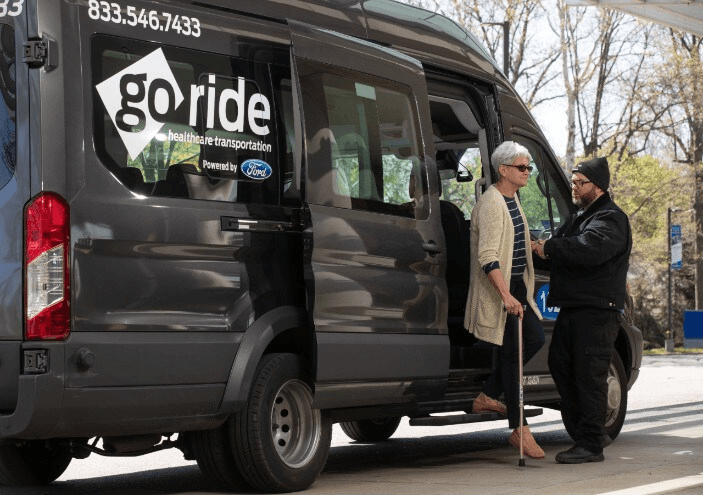
Credit: Ford GoRide
How it works: In May 2019, the Greater Dayton Regional Transit Authority (RTA) launched its partnership with Ford Motor Company to offer Ford GoRide Health (GoRide) first/last mile and paratransit service in Dayton, Ohio. While powered by Ford, the service is offered as part of RTA Connect, the collection of alternative transportation services offered by the RTA, which includes paratransit, bike share, first/last mile and general demand response services. Through this partnership, wheelchair accessible rides are provided to help connect individuals with disabilities to healthcare, jobs and other services. By partnering with Ford, RTA aims to enhance its paratransit and general demand response services, complement existing mobility options, and improve first/last mile access to fixed route services.
Unique partnership qualities: At the time of publication, the program has been shut down due to Ford’s business model pivoting to AV research. This example has still been included because the service model offered on-demand mobility services that were wheelchair accessible, had trained drivers, and was HIPAA compliant.
Additional information:
- Greater Dayton RTA to partner with Ford to expand services
- Ford GoRide Health Expands Nationally, Launches First Public Service
Pennsylvania – Rabbittransit Paratransit for Seniors and People with Disabilities
How it Works: To complement Rabbittransit’s existing paratransit service across a 10-county area in Central Pennsylvania, the transit agency partnered with Lyft and Uber for additional options to deliver ADA paratransit. Rabbittransit makes use of Pennsylvania’s Shared Ride Program funds, which allows senior citizens or an approved third-party sponsor to pay 15 percent of the fare, and the Lottery Fund pays the remaining 85 percent on local shared-ride transportation service. Rabbittransit books a TNC trip on behalf of its customers if the ride is determined to be cost effective and the customer is ambulatory. The program has been operating since May 2017 until the present. This option frees up capacity during peak hours for users who are not ambulatory, who still require traditional paratransit vehicles to get to their destination.
Unique partnership qualities: The service area spans 10 counties in Central Pennsylvania and the partnership with Lyft and Uber offers additional options to ADA paratransit.
Additional Information:
- American Public Transportation Association. Transit and TNC Partnerships.
Texas – Non-profit launches on-demand transportation pilot program for seniors and people with disabilities in rural counties

Credit: Feonix Mobility Rising
How it works: In early 2019, Feonix – Mobility Rising, a non-profit focusing on improving mobility options for under-served and vulnerable populations, began work with the Coastal Bend Center for Independent Living and the Area Agency on Aging to provide mobility options to the elderly and those with disabilities in coastal Texas. The program received a grant from the US National Aging and Disability Transportation Center, and with it, Feonix launch an on-demand volunteer driver program for seniors and people with disabilities providing service throughout Coastal Bend.
Unique partnership qualities: The Coastal Bend region includes two blighted urban counties and nine very rural counties, and the need for additional mobility services in the area had been documented by a regional transportation plan. Feonix also coordinated with the Coastal Plains Community Center to use the MaaS software they developed for a smaller pilot providing rides to a medical clinic; that pilot concluded after the grant period expired, but it served 30 unique individuals prior to its conclusion.
Additional information:
- Non-profit launches on-demand transportation pilot program for seniors and people with disabilities in rural counties, TX, 2019
- Feonix Mobility Rising: Coastal Bend Region website
Vermont – Go! Vermont Trip Planner
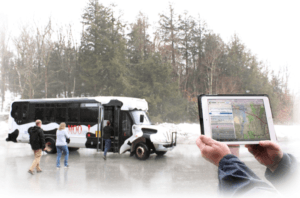
Source: VTrans; tablet displaying trip planning tool in front of VT Moover Bus
How it works: In partnership with Trillium and Cambridge Systematics, the Vermont Agency of Transportation (VTrans) has developed an online open-source trip planning application, which – by using GTFS-flex data – provides state-wide results that include more flexible transportation services such as dial-a-ride, hail-a-ride, and deviated fixed-routes. With this platform, users – particularly, non-traditional rural transit system users – gain a more complete picture of all their mobility options when planning a trip. The online platform was developed as a pilot project within the FTA MOD Sandbox program, and several other transit agencies have already taken steps to replicate the initiative’s resulting technologies. The Go! Vermont Trip Planner was established to serve both urban and rural areas across the state. Oftentimes, these areas, and in particular rural communities, do not have access to extensive fixed route services that traditional trip planners are developed to show. This new trip planner is also designed for people who have mobility challenges, as paratransit services that do not appear with Google Maps are available. By including services like dial-a-ride and wheelchair accessible vehicles into the results, the trip planner offers individuals with mobility challenges greater transportation options. Importantly, groups like the Vermont Association of the Blind and Visually Impaired and the Vermont Department of Disabilities, Aging, and Independent Living were engaged in the rollout of the trip planner to ensure that their community members were made aware of the services. Feedback from many of these groups and their members has been extremely positive.
Unique partnership qualities: The program offers an example of a statewide transportation planning tool that takes into consideration services for persons with a disability while crossing local political boundaries. This is particularly important in Vermont given the rural and small town areas and the need to travel from one jurisdictional boundary to another. The program is also based on open-source planning tools so that other locations can adapt it to their specific community needs.
Additional Information:
- Shared-Use Mobility Center. Case Study: Vermont Flexible Trip Planner—Bringing Fixed and Flexible Transit Together on a Single Platform.
Virginia – CARE On-Demand, Greater Richmond Transit Company (GRTC)
How it works: GRTC provided another mobility option for its ADA paratransit customers by partnering with two “reservation network companies” as a pilot in August 2017. The program is being run in GRTC’s service area, including the City of Richmond, Henrico County, and parts of Chesterfield County. UZURV is a TNC that provides all drivers with ADA and sensitivity training, and offers door-to-door service when needed by riders. Roundtrip is a web-based reservation service that has agreements with transportation providers in its network to serve the requested trips, including over 15 with accessible vehicles. Same day service for ADA paratransit riders is offered if booking is made at least two hours in advance. Personal care assistants ride and companions (space permitting) can also ride without charge. The program is being funded with a combination of state and local funds.
Unique partnership qualities: GRTC offers a same day on-demand service for persons with disabilities. Through the reservation system, riders are matched to a vehicle to meet their mobility needs, whether that is a TNC or a WAV. The one-stop shop creates efficiencies and a higher quality level of experience for its users.
Additional Information:
Washington – Seattle Bikeshare Permit Program
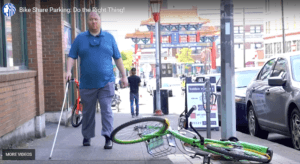
Informational video highlighting the importance of parking bikeshare bikes correctly for persons with disabilities. Seattle Department of Transportation Bikeshare Permit Program and Rooted in Rights.
How it works: By establishing a permanent regulatory framework for bikesharing, the Seattle Department of Transportation (SDOT) is seeking to harness the accessibility and reach of dockless bike companies. The new permitting process makes bikesharing available to people with disabilities, with $50,000 in permit fees redirected to create a program for an adaptive bikeshare partnership. Adaptive bicycles, which can include three-wheeled bikes, hand-pedaled cycles, recumbent cycles and others, can help fill an accessibility gap for riders with disabilities. Companies that deploy adaptive cycles will be allowed a “fleet-size bonus” of two additional bikes for each approved adaptive cycle deployed in the city up to 1,000 additional bicycles. The Seattle bikeshare permit also has measures to assure bikeshare bikes are parked properly and not obstructing the pedestrian right-of-way. SDOT partnered with Rooted in Rights, a non-profit organization that protects the rights of people with disabilities, to produce an informational video highlighting the importance of parking bikeshare bikes correctly.
Unique partnership qualities: The SDOT bikeshare permit program outlines a number of measures to assure correct usage, parking, and accessibility. The bikeshare program continues to grow and the permit offers a way to outline the operational conditions to form a strong Public-Private Partnership.
Additional Information:
-
- Shared-Use Mobility Center. Case Study: Seattle Bikeshare Program & Permit Process.
- Seattle Department of Transportation. Free-Floating Bike Share Program Permit Requirements.
Wisconsin – Milwaukee Adaptive Bikeshare Program
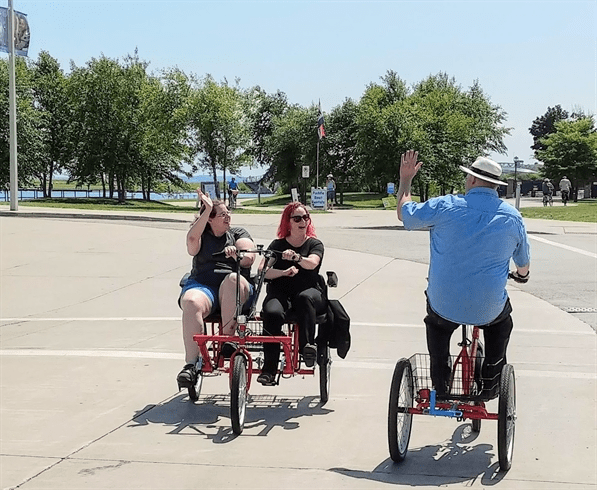
Credit: City of Milwaukee
How it works: In August 2019, the City of Milwaukee incorporated several adaptive bikes into its docked public bikeshare system, Bublr, for a 6-month pilot program. The vehicles – which include upright trikes, hand-cycles and 2-person side-by-side tandem bikes – can be located through the website or app-based system. The first phase of the pilot concluded in December 2019, and an evaluation of the pilot will be conducted before a second phase is launched in 2020.
Unique partnership qualities: Rather than making the adaptive bikes available at specified locations, the bikes can be accessed directly from the bikeshare stations.
Additional information:
Conclusion
This policy and program scan of shared use mobility has raised important issues regarding the advancement of these strategies for individuals with disabilities.
First, individuals with disabilities must be at the table in the planning, design, operations, and evaluation of these services. Second, the policy and program scan found that coordination of policy across different levels of government is beneficial to ensuring that shared-use mobility is an option for people with disabilities.
When developing policies or programs it is important to recognize that one size does not fit all and the unique characteristics of the neighborhood where these mobility services will occur must also be considered. Without this local understanding of the mobility needs, travel patterns and external factors, such as the topography or incidence of particular disability groups, a policy or program will likely not meet its intended goals. Involving the community in this process can produce valuable information and also help to build necessary community support.
New technologies have enabled mobility on demand. While these different mobility options are now available in the palm of your hand, they are often spread across different apps and payment systems and can sometimes be confusing to access. Early work from transit agencies has helped to bridge this gap through integrated trip planning and payment integration tools.
Finally, although this scan did not capture information about empirical outcomes related to inclusiveness of service, we were able to identify policy and programmatic characteristics that have the potential to facilitate inclusiveness. For instance, in those policies and practices that had the input of individuals with disabilities at multiple steps, it could be anticipated that the considerations for riders with disabilities would be embedded in the design and operations of the program. Similarly, when there was explicit language and reference to accessibility and equity in policy statements or program descriptions, a heightened level of inclusiveness could also be anticipated. The examples in this case study offer a beginning step toward understanding shared-use mobility partnerships and policies and how they can increase mobility options for persons with disabilities.
—
This research is based on the joint efforts between the Shared-Use Mobility Center and the National Center for Mobility Management.
The National Center for Mobility Management is a program of the Federal Transit Administration administered by Easterseals Inc., CTAA, and APTA.
Content in this document is disseminated in the interest of information exchange. Neither SUMC nor NCMM assumes liability for its contents or use.
